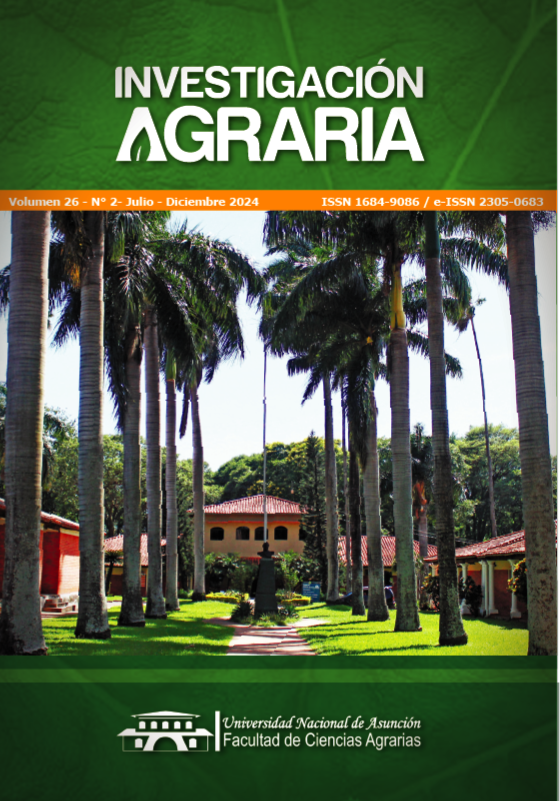Recognition of important weeds in juvenile stages in crops of Northeastern Argentina
DOI:
https://doi.org/10.18004/investig.agrar.2024.diciembre.2602807Keywords:
weeds, seedlings, scandens, monitoringAbstract
Agroecosystems in northeastern Argentina form important plant communities. Climbing weeds can become invasive. Monitoring and early detection of detrimental species can contribute to preventing infestations and are useful tools to achieve sustainable agriculture. The aim of the present study was to recognize, describe, and differentiate 12 weed species in juvenile stages. This was performed to facilitate monitoring and prevent weed invasion in yerba mate, tea, cassava, sweet potato, peanut, rice, and sunflower crops in 8 different locations in the provinces of Misiones, Corrientes, and Chaco. Vegetation surveys were carried out in different crops in 8 localities. Propagules were harvested from the most important weeds and stored in the refrigerator at 6°C. Subsequently, seeds and cuttings were placed in inert substrate with controlled humidity and at room temperature in plastic containers. A digital caliper and a standard flexometer were used. Likewise, photographs were taken with a smartphone and digital camera. Seedlings of 12 species were obtained, observed, morphologically described, illustrated, their parts were measured, their initial phenological stages were recorded, and they were taxonomically identified. A comparative table of the species studied, a dichotomous key for field recognition, and illustrations of the different taxa are presented. The morphological differences in seedling and young plant stages are important and sufficient to recognize these 12 species in the field and thus be able to choose IWM strategies aimed at the sustainability of agroecosystems in the northeastern region of Argentina.Downloads
Metrics
References
Alarcón Bravo, L. y Torres Reaño, G. (2016). Aspectos taxonómicos, germinación de semillas y conservación de germoplasma de los géneros Ipomoea y Merremia (Convolvulaceae) de la Región Lambayeque y zonas aledañas. (Tesis de Grado). Universidad Nacional Pedro Ruiz Gallo. Facultad de Ciencias Biológicas
Blanco, Y. y Leyva, A. (2007). Las arvenses en el agroecosistema y sus beneficios agroecológicos como hospederas de enemigos naturales. Cultivos Tropicales, 28(2), 21-28.
Burtnik, O. J. (2006). Yerba mate: Manual de Producción. INTA, AER Santo Tomé, Corrientes. 52 pág.
Cabanillas, P. A. y Hurrell, J. A. (2012). Plantas trepadoras: tipo biológico y clasificación. Revista Ciencias Morfológicas, 14(2): 1-15.
Carnevali, R. (1994). Fitogeografía de la Provincia de Corrientes. Pp. 324
Carrizo, E. del V. y Sobrero, Y. M. T. (2001). Descripción de las especies del género Ipomoea presentes en el área de riego del Río Dulce, Santiago del Estero, Argentina. Planta Daninha, Viçosa-MG, 19(2), 155-161.
Chiarini, F. y Ariza Espinar, L. (2006). 249 Convolvulaceae. En Flora Fanerogámica Argentina (F. F. A.), Vol. 96., pp. 1-81
Dávalos, C. M. (2017). “Malezas”. En Pablo Leandro Capellari. “Yerba Mate: Reseña histórica y estadística. Producción e Industrialización en el siglo XXI”. Buenos Aires. 48 p.
Dávalos, C. M., Vanni, R. O. y López, M. G. (2018). Relevamiento de malezas de yerba mate (Ilex paraguariensis A. St.-Hil.) del centro y sur de Misiones y NE de Corrientes. En II Congreso Argentino de Malezas ASACIM 2018. Rosario, Santa Fe.
Dávalos, C. M., Kalitko, M., Knott, K., Podkowa, F., Pawluk, L., Rem, V., López, M. G. y Vanni, R. O. (2019). Relevamiento de malezas frecuentes en el cultivo de yerba mate (Ilex paraguariensis A. St. Hil.) en lotes productivos de la provincia de Misiones. En 1ra Jornada
de Divulgación Científica Producción de Yerba Mate. FCF-UNaM, Eldorado-Misiones.
Dávalos, C. M. y Vucko, A. (2020). Comportamiento germinativo de semillas de Ipomoea nil (L.). Roth. Agrotecnia, 30, 112-116.
Dávalos, C. M., Wilson, B. D., Vallejos, F. E., Alsina, A. F., Benítez, A. E., Cardozo, A. E. y Vanni, R. O. (2023). Comunidad vegetal otoñal en un yerbal de la localidad de Andresito (Misiones). En XXVIII Reunión de Comunicaciones Científicas, Técnicas y de Extensión.
Corrientes: Universidad Nacional del Nordeste, p. 15
Fernández, O. A. (1982). Manejo Integrado de Malezas. Planta Daninha, V (2), pp. 69-79.
Fernández, O. A., Leguizamón, E., Acciaresi, H. A., Troiani, H. O. y Villamil, C. B. (2016). Malezas e invasoras de la Argentina : descripción y reconocimiento. Tomo II. Santiago del Estero: Editorial de la Universidad Nacional del Sur (Ediuns)
Font Quer, P. (1975). Diccionario de Botánica. 5ta reimpresión. Barcelona: Ed. LABOR
Freitas Leitao Filho, H. de, Aranha, C. y O. Bacchi. (1972). Plantas invasoras de culturas no Estado de Sao Paulo. Vol I: Instituto Campineiro de Ensino Agricola, Campinas, San Pablo. pp. 548.
Gliessmann, S. R. (2002). Agroecología. Procesos ecológicos en Agricultura Sostenible. Turrialba, Costa Rica: Ed. LITOCAT
Martínez Crovetto, R. (1963). Esquema fitogeográfico de la provincia de Misiones (República Argentina). Bonplandia, 1(3),171-223.
Marzocca, A. (1994). Guía descriptiva de malezas del Cono Sur. Buenos Aires, Instituto Nacional de Tecnología Agropecuaria (INTA), 304 p.
Ríos, E., Bogado, F., Merlo, W., Mussart, N., Acosta, C. y Acosta de Pérez, O. (2007). Hepatotoxicidad por Ipomoea carnea ssp. fistulosa (aguapeí, mandiyurá) de Argentina en cabras. Veterinaria México, 38(4), 419-428
Royo Simonella, L. A., López, M. G., Lovato Echeverría, R., Dávalos, C. M. y Vanni, R. O. (2022). Guía para la identificación de malezas del cultivo del algodón (Gossypium hirsutum L.) en la Provincia del Chaco. Universidad Nacional del Nordeste, 130 p.
Downloads
Published
How to Cite
Issue
Section
License
Copyright (c) 2025 Claudio Marcos Dávalos

This work is licensed under a Creative Commons Attribution 4.0 International License.
All content in this journal is under Creative Commons Attribution License.









 All content in this journal is under
All content in this journal is under 